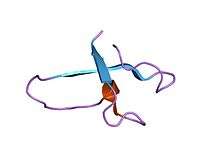B-box zinc finger
In molecular biology the B-box-type zinc finger domain is a short protein domain of around 40 amino acid residues in length. B-box zinc fingers can be divided into two groups, where types 1 and 2 B-box domains differ in their consensus sequence and in the spacing of the 7-8 zinc-binding residues. Several proteins contain both types 1 and 2 B-boxes, suggesting some level of cooperativity between these two domains.
| zf-B_box | |||||||||
|---|---|---|---|---|---|---|---|---|---|
 Structure of the xnf7 B-box, developmental protein | |||||||||
| Identifiers | |||||||||
| Symbol | zf-B_box | ||||||||
| Pfam | PF00643 | ||||||||
| InterPro | IPR000315 | ||||||||
| PROSITE | PDOC50015 | ||||||||
| SCOPe | 1fre / SUPFAM | ||||||||
| CDD | cd00021 | ||||||||
| |||||||||
Occurrence
B-box domains are found in over 1500 proteins from a variety of organisms. They are found in TRIM (tripartite motif) proteins that consist of an N-terminal RING finger (originally called an A-box), followed by 1-2 B-box domains and a coiled-coil domain (also called RBCC for Ring, B-box, Coiled-Coil). TRIM proteins contain a type 2 B-box domain, and may also contain a type 1 B-box. In proteins that do not contain RING or coiled-coil domains, the B-box domain is primarily type 2. Many type 2 B-box proteins are involved in ubiquitinylation. Proteins containing a B-box zinc finger domain include transcription factors, ribonucleoproteins and proto-oncoproteins; for example, MID1, MID2, TRIM9, TNL, TRIM36, TRIM63, TRIFIC, NCL1 and CONSTANS-like proteins.[1]
The microtubule-associated E3 ligase MID1 (EC) contains a type 1 B-box zinc finger domain. MID1 specifically binds Alpha-4, which in turn recruits the catalytic subunit of phosphatase 2A (PP2Ac). This complex is required for targeting of PP2Ac for proteasome-mediated degradation. The MID1 B-box coordinates two zinc ions and adopts a beta/beta/alpha cross-brace structure similar to that of ZZ, PHD, RING and FYVE zinc fingers.[2][3]
Homologs
Prokaryotic homologs of the domain are present in several bacterial lineages and methanogenic archaea, and often show fusions to peptidase domains such as the rhomboid-like serine peptidase, and Zn-dependent metallopeptidase. Other versions typically contain transmembrane helices and might also show fusions to domains such as DNAJ, FHA, SH3, WD40 and tetratricopeptide repeats. Together these associations suggest a role for the prokaryotic homologs of the B-box zinc finger domain in proteolytic processing, folding or stability of membrane-associated proteins. The domain architectural syntax is remarkably similar to that seen in prokaryotic homologs of the AN1 zinc finger and LIM domains.[4]
References
- Short KM, Cox TC (March 2006). "Subclassification of the RBCC/TRIM superfamily reveals a novel motif necessary for microtubule binding". J. Biol. Chem. 281 (13): 8970–80. doi:10.1074/jbc.M512755200. PMID 16434393.
- Massiah MA, Matts JA, Short KM, Simmons BN, Singireddy S, Yi Z, Cox TC (May 2007). "Solution structure of the MID1 B-box2 CHC(D/C)C(2)H(2) zinc-binding domain: insights into an evolutionarily conserved RING fold". J. Mol. Biol. 369 (1): 1–10. doi:10.1016/j.jmb.2007.03.017. PMID 17428496.
- Massiah MA, Simmons BN, Short KM, Cox TC (April 2006). "Solution structure of the RBCC/TRIM B-box1 domain of human MID1: B-box with a RING". J. Mol. Biol. 358 (2): 532–45. doi:10.1016/j.jmb.2006.02.009. PMID 16529770.
- Burroughs AM, Iyer LM, Aravind L (July 2011). "Functional diversification of the RING finger and other binuclear treble clef domains in prokaryotes and the early evolution of the ubiquitin system". Mol. Biosyst. 7 (1): 2261–77. doi:10.1039/C1MB05061C. PMC 5938088. PMID 21547297.